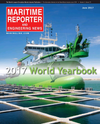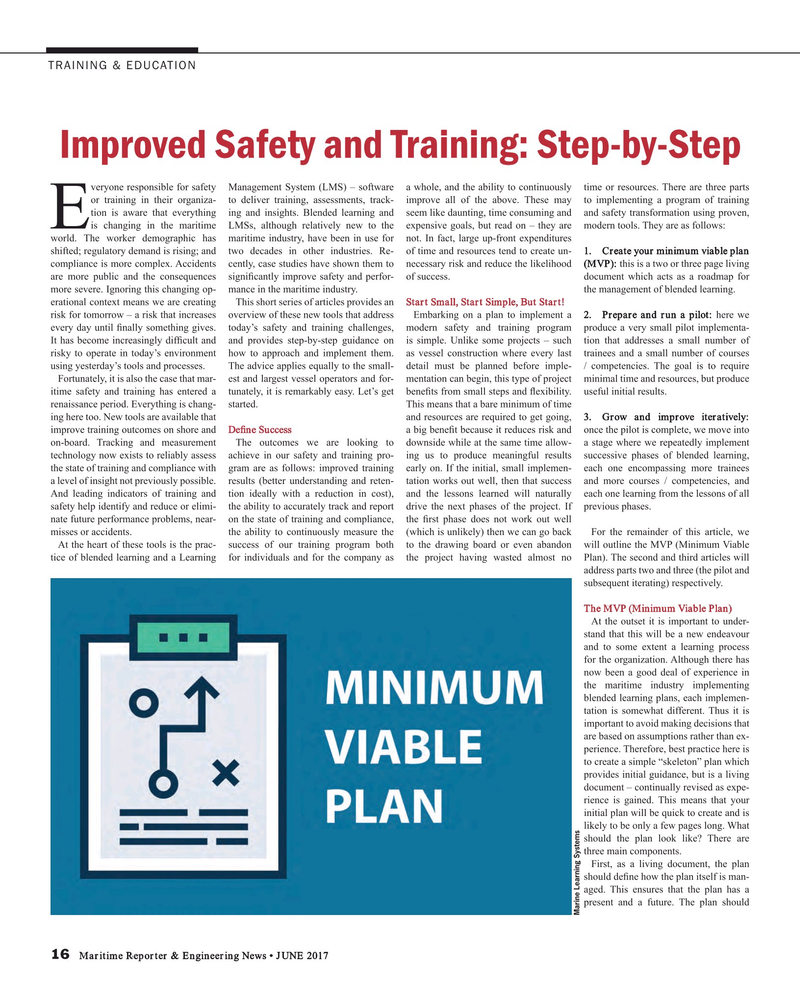
Page 16: of Maritime Reporter Magazine (June 2017)
U.S. Navy Quarterly
Read this page in Pdf, Flash or Html5 edition of June 2017 Maritime Reporter Magazine
TRAINING & EDUCATION
Improved Safety and Training: Step-by-Step veryone responsible for safety Management System (LMS) – software a whole, and the ability to continuously time or resources. There are three parts or training in their organiza- to deliver training, assessments, track- improve all of the above. These may to implementing a program of training tion is aware that everything ing and insights. Blended learning and seem like daunting, time consuming and and safety transformation using proven,
Eis changing in the maritime LMSs, although relatively new to the expensive goals, but read on – they are modern tools. They are as follows: world. The worker demographic has maritime industry, have been in use for not. In fact, large up-front expenditures shifted; regulatory demand is rising; and two decades in other industries. Re- of time and resources tend to create un- 1. Create your minimum viable plan compliance is more complex. Accidents cently, case studies have shown them to necessary risk and reduce the likelihood (MVP): this is a two or three page living are more public and the consequences signi? cantly improve safety and perfor- of success. document which acts as a roadmap for more severe. Ignoring this changing op- mance in the maritime industry. the management of blended learning.
erational context means we are creating This short series of articles provides an Start Small, Start Simple, But Start!
risk for tomorrow – a risk that increases overview of these new tools that address Embarking on a plan to implement a 2. Prepare and run a pilot: here we every day until ? nally something gives. today’s safety and training challenges, modern safety and training program produce a very small pilot implementa-
It has become increasingly dif? cult and and provides step-by-step guidance on is simple. Unlike some projects – such tion that addresses a small number of risky to operate in today’s environment how to approach and implement them. as vessel construction where every last trainees and a small number of courses using yesterday’s tools and processes. The advice applies equally to the small- detail must be planned before imple- / competencies. The goal is to require
Fortunately, it is also the case that mar- est and largest vessel operators and for- mentation can begin, this type of project minimal time and resources, but produce itime safety and training has entered a tunately, it is remarkably easy. Let’s get bene? ts from small steps and ? exibility. useful initial results.
renaissance period. Everything is chang- started. This means that a bare minimum of time ing here too. New tools are available that and resources are required to get going, 3. Grow and improve iteratively: improve training outcomes on shore and De? ne Success a big bene? t because it reduces risk and once the pilot is complete, we move into on-board. Tracking and measurement The outcomes we are looking to downside while at the same time allow- a stage where we repeatedly implement technology now exists to reliably assess achieve in our safety and training pro- ing us to produce meaningful results successive phases of blended learning, the state of training and compliance with gram are as follows: improved training early on. If the initial, small implemen- each one encompassing more trainees a level of insight not previously possible. results (better understanding and reten- tation works out well, then that success and more courses / competencies, and
And leading indicators of training and tion ideally with a reduction in cost), and the lessons learned will naturally each one learning from the lessons of all safety help identify and reduce or elimi- the ability to accurately track and report drive the next phases of the project. If previous phases.
nate future performance problems, near- on the state of training and compliance, the ? rst phase does not work out well misses or accidents. the ability to continuously measure the (which is unlikely) then we can go back For the remainder of this article, we
At the heart of these tools is the prac- success of our training program both to the drawing board or even abandon will outline the MVP (Minimum Viable tice of blended learning and a Learning for individuals and for the company as the project having wasted almost no Plan). The second and third articles will address parts two and three (the pilot and subsequent iterating) respectively.
The MVP (Minimum Viable Plan)
At the outset it is important to under- stand that this will be a new endeavour and to some extent a learning process for the organization. Although there has now been a good deal of experience in the maritime industry implementing blended learning plans, each implemen- tation is somewhat different. Thus it is important to avoid making decisions that are based on assumptions rather than ex- perience. Therefore, best practice here is to create a simple “skeleton” plan which provides initial guidance, but is a living document – continually revised as expe- rience is gained. This means that your initial plan will be quick to create and is likely to be only a few pages long. What should the plan look like? There are three main components.
First, as a living document, the plan should de? ne how the plan itself is man- aged. This ensures that the plan has a present and a future. The plan should
Marine Learning Systems 16 Maritime Reporter & Engineering News • JUNE 2017
MR #6 (10-17).indd 16 MR #6 (10-17).indd 16 6/7/2017 11:04:02 AM6/7/2017 11:04:02 AM

 15
15

 17
17
